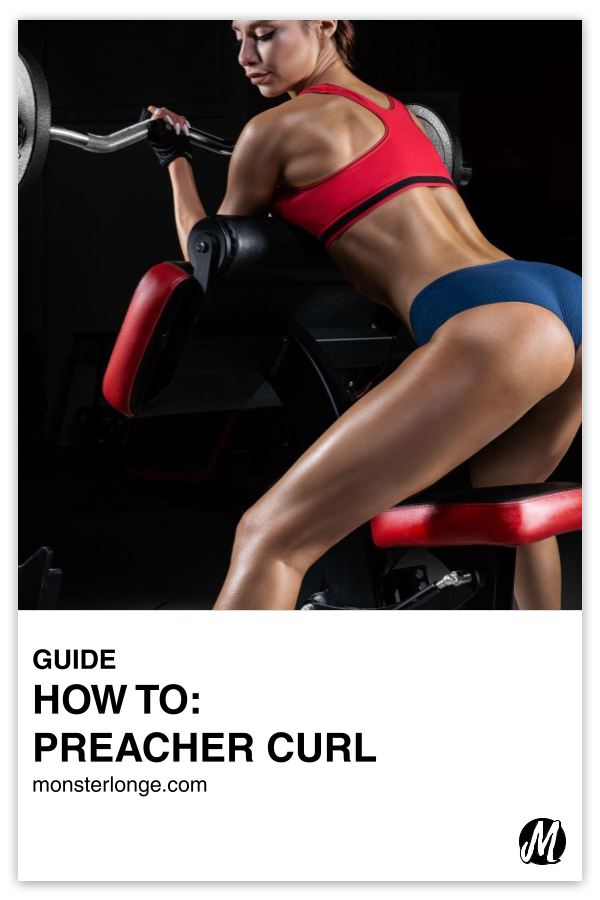
How To: Preacher Curl
Are you a cheater?
Like, do your elbows move instead of staying stationary by your side when you do standing barbell curls or seated and standing dumbbell curls? If your elbows travel forward past your torso during those biceps movements, then you’re rocking your body to move the weight or getting assistance from your front delts. Either way, you’re a cheater.1You’re also a cheater because, you know, you’re not faithful to the person you’re in a relationship with!
When you cheat in the manner described, your arms get robbed of the benefit of traditional curls. The solution is to correct your form and possibly use less weight, as trying to lift too much itself may be the reason for the improper technique. Another remedy is the preacher curl, which is so named for the preacher bench it’s performed on, which in turn has to do with the resemblance to the slanted pulpit that preachers deliver their sermon from.
In its simplest description, the preacher bench consists of an angled pad that you rest your upper body on while the rest of the body is immobilized behind it. While it’s still possible to cheat with preacher curls like any other exercise, the design of the preacher bench increases the difficulty in two ways. The first is that the fixed position of the arms makes it hard for the shoulders to provide a lot of mechanical assistance. Second, the ability to use your lower body to generate momentum is minimized, though possible. Given these two elements, it takes real deliberate intention to cheat on preacher curls.
As we see, the setup of preacher curls limits cheating. Apart from that, another benefit of the way the bench is constructed is that with the stability provided by the pad, you’re able to control the eccentric portion of the lift, which places the biceps under constant tension and creates a lot of muscle damage, thus increasing the potential for greater biceps growth. Taken as a whole, all of these things make preacher curls perfect for isolating the biceps and are why the exercise should be included in your arm training program.
INSTRUCTIONS
1). Position yourself with your chest high against the flat side of the arm pad and your armpits over the top of the pad so your arms extend down the angled side.2NOTE: Depending on the type of preacher curl station, you may have the option to sit or stand. Regardless of the type, the instructions are the same.
2). Grab the barbell with your palms facing up.3The exact position, or spacing, of your hands by which you hold the barbell will depend on your goal. So if you want to target the outer biceps, then use a narrow grip so your hands are so close to one another on the barbell that they’re about to touch. For the inner biceps, use a wide grip. To work both, position your hands shoulder-width apart and make sure your wrists, elbows, and shoulders form a straight line with one another.
3). Remove the barbell from the rack and breathe out as you brace your core and bring the weight toward you by bending your elbows while actively pressing your arms into the pad and imagining that you’re pushing your feet through the ground.4Don’t involve the shoulders by rounding them over too much or lean back and raise the shoulders as you lift the bar. Also, if executing the movement seated, your ass should remain on the seat throughout the set rather than it coming off between reps to make the exercise easier.
4). When the weight is lifted all the way up so your forearms are in direct contact with your biceps, pause for 1-2 seconds and squeeze your biceps.
5). Breathe in and lower the weight in a slow, controlled manner until your arms are fully extended but not locked out.
6). Repeat.
NOTE (1): The “W” design of a cambered, or E-Z curl, bar puts less strain on the wrists than a straight bar. So use that rather than a straight bar if you experience any pain or discomfort in your wrists as you execute the movement.
NOTE (2): Preacher curls aren’t an exercise you should ever use excessive weight for. Given the angled surface and fixed position of the arms, trying to lift more weight than you can on the preacher curl can compromise your form and strain the biceps, if not result in tendon damage from a complete tear of the muscle. Due to this risk, use only light to moderate weight and focus on controlling the movement to increase the difficulty rather than by way of overloading the muscle with heavy weight.
For a workout routine that possibly includes preacher curls, as well as other exercises geared specifically to your goals, training experience, injury history, and available equipment, then find out more HERE
Glossary: arms, barbell, biceps, cheat, chest, dumbbell, exercise, exercise equipment, goal, gym, lifting form, muscle, program, reps, routine, workout
- How To Eat Healthy During Thanksgiving - November 20, 2024
- Weight Loss Tip: no.2620 - November 20, 2024
- Is Going To The Gym Once A Week Enough? - November 19, 2024
